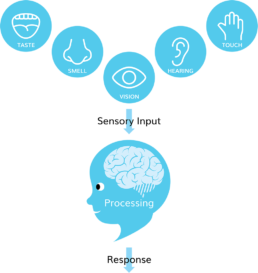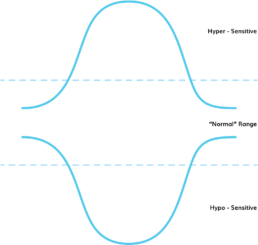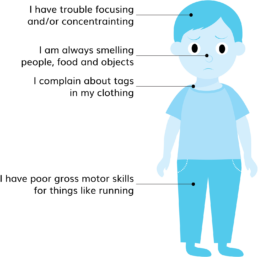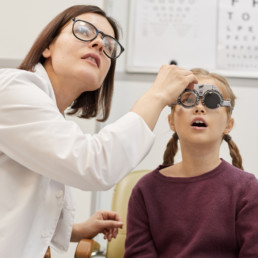Share on
It’s a Sunday afternoon and you’re taking a walk through the park. You listen to the birds singing in the trees above, and as you try to avoid a speeding cyclist, a group of children runs past you chasing a football. As soon as you’re out of danger, you detect the smell of hot dogs and walk towards a crowded street hoping to find a hot dog stand.
The above may seem like a simple, everyday situation but a lot happens behind the scenes for you to avoid the speeding cyclist and arrive to the hotdog stand. Your brain needs to detect all the information coming in from different senses and integrate them into an output that you can understand and react to. Sensory integration is the way in which the central nervous system receives signals from all the senses in the body and then uses that information to respond in an appropriate way. When you saw the cyclist approaching your brain immediately sent a signal to your muscles, effectively putting you out of way’s harm.

In some people, the brain has a hard time taking in and responding to information coming through the senses. In most daily situations, our brain must simultaneously process sounds, smells, tastes and textures in order to form a coherent picture of our surroundings. Sensory processing issues occur when the brain cannot organize all this information correctly. A child with a sensory processing disorder would most likely feel overwhelmed in the park described above, or be unable to process all stimuli at once and miss the cyclist. In other words, they might experience a feeling of “sensory overload”. This inability to use information received through the senses correctly is also known as Sensory Integration Disorder or Sensory Processing Disorder (SPD) and it can have a big impact on everyday life.
SPD may affect only one sense or many. Every person will react in a different way and have a different response to incoming stimuli. Responses can be divided to oversensitivity (hypersensitivity) or under sensitivity (hyposensitivity), while some people will experience both. Over sensitivity usually leads to avoiding certain stimuli because it’s overwhelming, or sensory avoidance. In children this might show as being unusually quiet or passive because they don’t notice things that other people do. Under sensitivity however can lead to a person becoming more “sensory seeking”, that is looking for more sensory stimulation by constantly moving or touching everything. Triggers that often make children feel overwhelmed and upset include bright lights, specific food textures or scratchy clothing.

When we talk about the senses, our understanding is usually limited to the traditional five senses: sight, smell, taste, touch and sound. There are however two more senses that are less often talked about but are equally important in understanding sensory integration issues, interoception and proprioception. Interoception is a kind of internal feeling that helps you feel and understand what’s going on in your body. Without this sense it would be much harder knowing when you’re cold, tired or hungry. Proprioception on the other hand is a knowledge of one’s body, its movements and where it is in space. Children with SPD might have a lower pain threshold, might be afraid of using swings in playgrounds and have troubles knowing where their body is in relation to other children.




SPD is currently not recognized as a disorder on its own and you will not find it in the Diagnostic Statistical Manual (DSM) or any other diagnostic manual. It is often linked to other conditions, most commonly Autism Spectrum Disorder, Attention Deficit Hyperactivity Disorder (ADHD), Schizophrenia or Post Traumatic Stress Disorder (PTSD). Treatments will therefore vary according to the specific diagnosis and a child’s needs. Some of the most common treatments are vision therapy to improve eye-hand motor coordination skills, listening therapy for getting accustomed to multiple sound frequencies and different lifestyle changes to accommodate the child’s needs. An example of a lifestyle change can be using noise-cancelling headphones in public transport or wearing sunglasses in bright lights. The complexity of SPD means that choosing the right treatment is a very individual process, might require a combination of approaches and therefore take a long time. It is therefore important to find the right specialist early and to be patient and flexible. After all, everyone’s walk in the park is a special and individual experience.
Latest Knowledge Articles
Seeing in 3D – importance of depth perception

The eyes can look normal but a difficult type of amblyopia to detect




